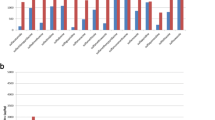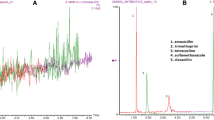Abstract
The objective of this study was to evaluate (qualitatively and quantitatively) the occurrence of antibiotic residue in pasteurized milk in Brazil. Pasteurized milk samples (n = 252) were collected monthly from Nov. 2010–Oct. 2011 from 21 commercial establishments (brands). A screening test (Delvotest® SP-NT) was applied to those samples. In positive (n = 19) and/or suspect samples (n = 24), we quantified oxytetracycline (OTC) and tetracycline (TC) by high-performance liquid chromatography with diode array detector (HPLC-DAD). OTCs were detected in all positive samples and TCs in six. In the 24suspected samples, OTCs were detected in 23 and TCs were not found in 8. Of the milk brands evaluated (n = 21), the presence of antibiotic residue was not detected in 4; in the other brands, both positive and suspect samples were verified. Results indicate the presence of antibiotic residue above legal limits. According to actual milk consumption in Brazil (441 mL/kg BW/day), in only 9 of the 17 brands of milk with antibiotic residue, the estimated daily intake was at or less than the maximum recommended by the European Union. The screening test used was effective to identify the presence of antibiotic residue (OTC and TC), confirmed by HPLC-DAD. The OTC is the predominant antimicrobial used by dairy farmers. Ingestion of contaminated milk by OTC and TC can increase the resistance of microorganisms to antibiotics.





Similar content being viewed by others
References
Bando E, Oliveira RC, Ferreira GM, Machinski M Jr (2009) Occurrence of antimicrobial residues in pasteurized milk commercialized in the state of Paraná, Brazil. J Food Prot 72(4):911–914
Bansal BK, Bajwa NS, Randhawa SS, Ranjan R, Dhaliwal PS (2011) Elimination of erythromicynin in milk after intramammary administration in cows with specific mastitis: relation to dose, milking frequency, and udder health. Trop Anim Health Prod 43:323–329
Barbano DM, Rasmussen RR, Lynch JM (1991) Influence of milk somatic cell count and milk age on cheese yield. J Dairy Sci 74:369–388
Brasil. 2003. National Agency of Sanitary Vigilance. Health Ministry. Resolução RDC N. 119. PAMVET. Diário Oficial da União, 2003; 18 de setembro.
Brasil. (2011) Agricultural, Livestock and Supply Ministry. Normative Instruction, nº 62 de 29 de Dec.-2011. Diário Oficial da União. Brasília, 29 de dezembro de 2011.
Can HY, Çelik TH (2012) Detection of enterotoxigenic and antimicrobial resistant S. aureus in Turkish cheeses. Food Control 24:100–103
Carvalho PN, Pirra A, Basto MCP, Almeida CMR (2013) Activated sludge systems removal efficiency of veterinary pharmaceuticals from slaughterhouse wastewater. Environ Sci Pollut Res. doi:10.1007/s11356-013-1867-7
Codex Alimentarius. (2012). Codex Alimentarius Commission Maximum Residue Limits for Veterinary Drugs in Food. Updated as at the 34th Session of the Codex Alimentarius Commission (July 2011).http://www.codexalimentarius.org/committees-task-forces/en/?provide=committeeDetail&idList=6. Accessed 04 Oct. 2013.
Costa Sobrinho PS, Faria CAM, Pinheiro JS, Almeida HG, Pires CV, Santos AS (2012)Bacteriological Quality of Raw Milk Used for Production of a Brazilian Farmstead Raw Milk Cheese. Foodborne Pathog Dis 9(2). doi:10.1089/fpd.2011.1010.
Davies L, O’connor M, Logan S (2003) Chronic intake. In Pesticide Residues in Food and Drinking Water: Human Exposure and Risks. John Wiley & Sons Ltd, Chichester
ANVISA - Agência Nacional de Vigilância Sanitária (2003). Resolução Re. Nº 899, de 29 de Maio de 2003.
Denobile M, Nascimento SE (2004) Method validation for the determination of the antibiotics residues oxytetracycline, tetracycline, chlortetracycline, and doxycycline in milk by high-performance liquid chromatography. Rev Bras Ciên Farm 40:209–218, in portuguese
Dohoo IR, Leslie KE (1991) Evaluation of changes in somatic cell counts as indicators of new intramammary infections. Prev Vet Med 10:225–237
Embrapa—Empresa Brasileira de Pesquisa Agropecuária. NationalMilkDiagnostic. 2013. http://www.cnpgl.embrapa.br/nova/Plano_Pecuario_2012.pdf (in portuguese). Accessed 07 may 2013.
EMEA. (1995). Oxytetracycline, Tetracycline, Chlortetracycline, summary report (3) committee for veterinary medicinal products. EMEA. EMEA/MRL/023/95.
FAO. (2013). Food and Agriculture Organization for United Nations. Statistics. Acces 09/12/2013.http://www.fao.org/economic/ess/en/#.Ug5-KJLVAZ4.
Farina EMMQ, Gutman GE, Lavarello PJ, Nunes R, Reardon T (2005) Private and public milk standards in Argentina and Brazil. Food Policy 30:302–315
Fonseca GP, Cruz AG, Faria JAF, Silva R, Moura MRL, Carvalho MRJ (2009) Antibiotic residues in Brazilian UHT milk: a screening study. Ciênc Tecnol Aliment Campinas 29(2):451–453, abr.-jun. 2009
Food and Agriculture Organization of the United Nations & World Health Organization (2000). Codex Alimentarius Commission. CX/RVDF 00/12. Joint Fao/Who Food Standards Programme Codex Committee on Residues of Veterinary Drugs in Foods. Twelfth Session, Washington, D.C.
Freitas SKB, Paim APS, Silva PTS (2013) Development of a LC-IT-TOF MS procedure to quantify veterinary drug residues in milk employing a QuEChERS approach. Food Anal Methods. doi:10.1007/s12161-013-9595-7
Gao J, Yu FQ, Luo LP, He JZ, Hou RH, Zhang HQ, Li SM, Su JL, Han B (2012) Antibiotic resistance of Streptococcus agalactiae from cows with mastitis. Vet J 194:423–424
Goto T, Ito Y, Yamada S, Matsumoto H, Oka H (2005) High-throughput analysis of tetracycline and penicillin antibiotics in animal tissues using electrospray tandem mass spectrometry with selected reaction monitoring transition. J Chromatogr A 1100:193–199
Hennart, S. T. A.; Faragher, J. 2012. Validation of Delvotest SP NT DA.JAOAC, 95, 252.
Ilić K, Jakovljević E, Škodrić-Trifunović V (2012) Social–economic factors and irrational antibiotic use as reasons for antibiotic resistance of bacteria causing common childhood infections in primary healthcare. Eur J Pediatr 171:767–777
Juan C, Moltó JC, Mañes J, Font G (2010) Determination of macrolide and lincosamide antibiotics by pressurized liquid extraction and liquid chromatography tandem mass spectrometry in meat and milk. Food Control 21:1703–1709
Kaya SE, Filazi A (2010) Determination of antibiotic residues in milk samples. Kafkas Univ Vet Fak Derg 16(Suppl-A):S31–S35
Kennedy DG, McCracken RJ, Cannavan A, Hewitt SA (1998) Use of liquid chromatography–mass spectrometry in the analysis of residues o antibiotics in meat and milk. J Chromatogr A 812:77–98
Knappstein K, Suhren G, Walte GH (2003) Influence of milking frequency on withdrawal period after application of beta-lactam antibiotic-based drugs. Anal Chim Acta 48(3):241–249
Le Breton MH, Savoy-Perroud MC, Diserens JM (2007) Validation and comparison of the Copan milk test and Delvotest SP-NT for the detection of antimicrobials in milk. Anal Chim Acta 586:280–283
Linage B, Gonzalo C, Carriedo JA, Asensio JA, Blanco MA, La Fuente LF, Primitivo FS (2007) Performance of blue-yellow screening test for antimicrobial detection in ovine milk. Jour Dairy Sci 90:5374–5379
Mamani MCV, Reyes FGR, Rath S (2009) Multiresidue determination of tetracyclines, sulfonamides, and chloramphenicol in bovine milk using HPLC-DAD. Food Chem 117:545–552
Martins-Júnior HA, Kussumi TA, Wang AY, Lebre DT (2007) A rapid method to determine antibiotic residues in milk using Liquid Chromatography Coupled to Electrospray Tandem Mass Spectrometry. J Braz Chem Soc 18(2)397–405
Mazal G, Vianna PCB, Santos MV, Gigante ML (2007) Effect of somatic cell count on Prato cheese composition. J Dairy Sci 90:630–636
Moscati MCL, Gan MA (2007) Rainfall variability in the rainy season of semiarid zone of Northeast Brazil (NEB) and its relation to wind regime. Int J Climatol 27:493–512
Oliveira LP, Barros LSS, Silva VC, Cirqueira MG (2012) Microbiological quality and detection of antibiotic residue in raw and pasteurized milk consumed in the Reconcavo Area of the State of Bahia, Brazil. Food Process Technol 3(1):2–5. doi:10.4172/2157-7110.1000137
Schlegelova J, Babák V, Klímová E, Lukásová J, Navrátilová P, Sústácková A, Sédivá I, Rysánek D (2002) Prevalence of and resistance to anti-microbial drugs in selected microbial species isolated from bulk milk samples. J Vet Med B 49:216–225
Sierra D, Contreras A, Sánches A (2009) Short-communication: detection limits of non-beta-lactam antibiotics in goat's milk by microbiological residues screening tests. J Dairy Sci 92:4.200–4.206
Stockler RM, Morin DE, Lantz RK, Constable PD (2009) Effect of milking frequency and dosing interval on the pharmacokinects of cephapirin after intramammary infusion in lactating cows. J Dairy Sci 92:4262–4275
Stolker AAM, Brinkman UA (2005) Analytical strategies for residue analysis of veterinary drugs and growth-promoting agents in food-producing animals—a review. J Chromatogr Anal 1067:15–53
Acknowledgments
This research was funded by Fundacao de Amparo a Pesquisa do Estado da Bahia (FAPESB) and Coordenacao de Aperfeicoamento de Pessoal de Nivel Superior (Capes) for the support to the research.
Conflict of interest
None of the author has any support or relationship with other people that could inappropriately influence.
Author information
Authors and Affiliations
Corresponding author
Additional information
Responsible editor: Philippe Garrigues
Rights and permissions
About this article
Cite this article
de Albuquerque Fernandes, S.A., Magnavita, A.P.A., Ferrao, S.P.B. et al. Daily ingestion of tetracycline residue present in pasteurized milk: a public health problem. Environ Sci Pollut Res 21, 3427–3434 (2014). https://doi.org/10.1007/s11356-013-2286-5
Received:
Accepted:
Published:
Issue Date:
DOI: https://doi.org/10.1007/s11356-013-2286-5




